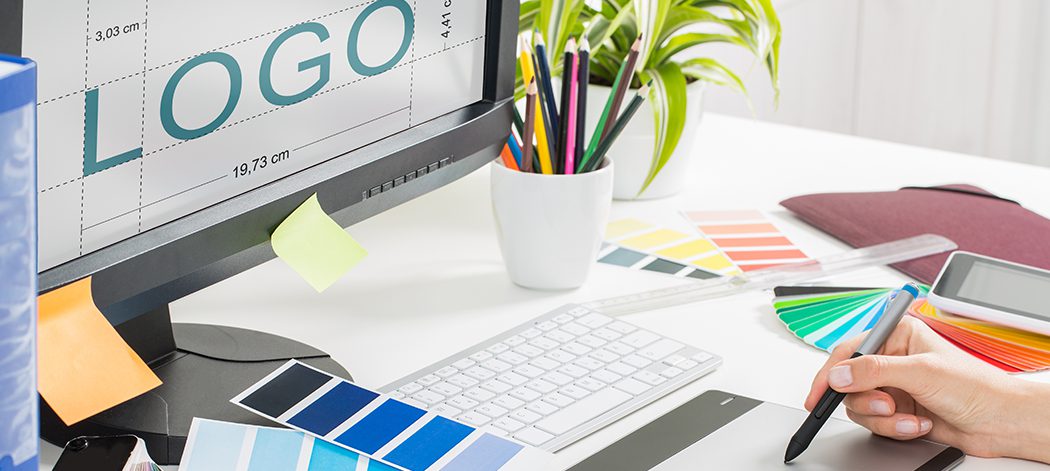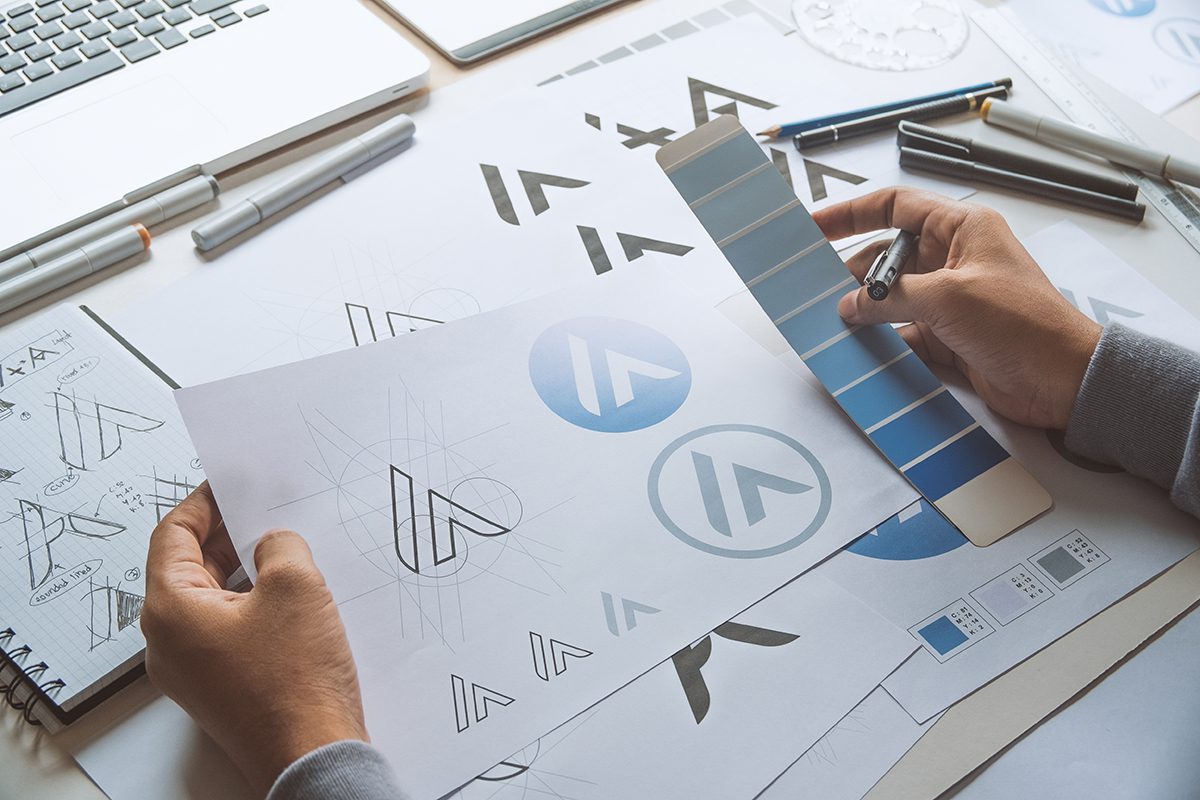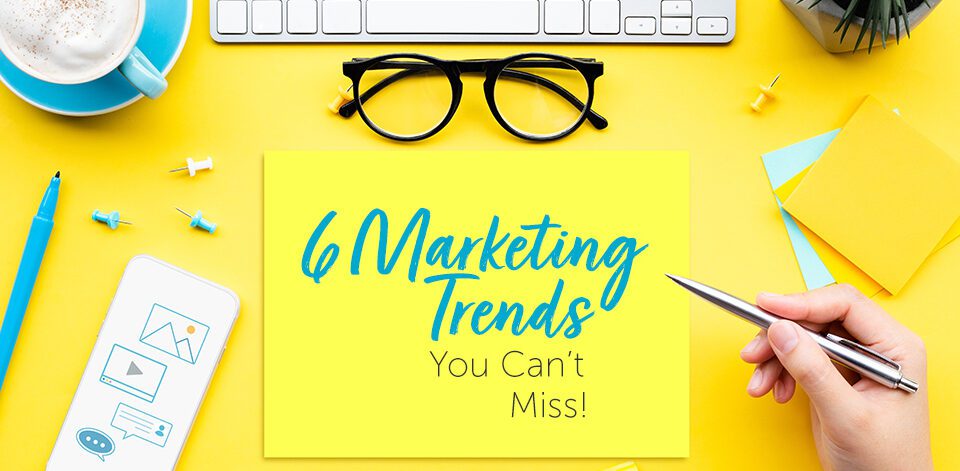A professional logo design is a business’ identity to the world. Wondering how? Sit back and think when you see an image of a half-eaten apple, what’s the first idea that strikes in your head? The giant iPhone company, Apple. Isn’t it?
Branding is a combination of strategy, skill, and creativity that shapes the identity of your company. As a result, it provides a unique position campared to competitors and builds a connection with customers. Therefore, successful branding creates a memorable impression in the minds of your target audience. Moreover, a professional logo design encourages lifelong relationships with your constituents. Now you see why a half-eaten apple reminded you of the company Apple…
When working on branding, you need to brainstorm various factors. Some of them include defining your business, its offerings, and the target audience. It also includes establishing brand values, identifying your unique selling point (USP), tagline, market position, etc. Apart from these, branding also involves creating a brand identity. In other words, it’s the face, the look, and the feel of your company. And this is where your company logo plays the leading role. Read on to understand why a professional logo is vital, what makes a good logo, and some of the best examples of company logos.
What is a Logo?
Simply put, a logo could be a graphic design, an emblem, a symbol, or even a brand name. Its primary use is to identify a particular company, organization, or brand. Thus, when a professional logo design becomes an easily recognizable symbol, like the tick mark of Nike or the yellow ‘M’ of McDonald’s, it becomes an invaluable intangible asset for an enterprise. And that’s why most companies trademark their logos as their intellectual property.
Why is a professional logo design important?
A professional logo design is highly crucial for your business. Here are some reasons why.
1. It grabs the attention of the target audience:
There’s a popular tool known as AIDA, which stands for Attention, Interest, Desire, and Action digital marketing. From this, it is clear that the first task of a marketer is to grab the attention of its target customers. In a world where human attention span lasts a few seconds, companies get only 2 seconds to convince their potential customers that they offer something that might interest them. The best way to do so is by presenting your logo. A visual or pictorial representation of your brand will instantly grab the attention of the viewers for visual marketing. It will communicate your brand ideology in an interesting and creative way that builds curiosity among the target audience, making them stop and check out your offerings.
2. A professional logo design makes a great first impression:
While you might not believe in the saying, “The first impression is the last impression,” first impressions do make a powerful impact on others. In the business world, the company logo acts as its face, its identity, and thus, its introduction. It is for this reason, you should create the logo design carefully. If this job is done right, your brand logo would draw the attention of the customers and build their interest in the company. On the contrary, if you fail to create a good logo design, you might fail to attract a great chunk of your customer base. For a memorable first impression, the logo design should be such that it can immediately introduce the brand definition to the customers. Are you a fast-food chain, a smartphone company, or an automobile manufacturer? Your logo should answer it clearly and creatively.
3. It gets used in all your communications:
Today, every enterprise needs to market its products and services across multiple online and offline channels. When people see the logo anywhere, they get instantly reminded of your company and its products and services.
4. It establishes your brand identity:
Your logo design acts as an identity card for your company. It delivers all the basic information about your business, such as who you are, what you do, and for whom, clearly and concisely. Along with introducing the company, it also attracts and engages the target audience. The colors, fonts, and graphics used in a logo design communicate specific meanings. Many companies even incorporate hidden messages in their logo designs, which sets the stage for the narration of interesting anecdotes related to the company.
5. A professional logo design makes you unique:
People always crave something new and unique. Through your logo design, you can tell them that you are indeed what they were desiring. Your company logo tells the public why you are different from your competitors. It conveys your values and ideologies to the people and thus, shows them that you are unique. And it helps in attracting new customers and ensuring the growth of your business.
6. It encourages brand loyalty:
Apart from attracting new customers, retaining the existing ones is also essential. As your company will expand, the company logo will become familiar to the audience. It will show that you are legitimate and trustworthy. As an example, think about your shopping behavior. While purchasing a pair of sports shoes, would you rather prefer the one having an unfamiliar logo or the one that has the Nike swoosh? If you go for the latter, you know you’re in safe hands. You have faith in the company as it is tried and tested. This is how a logo can foster brand loyalty among consumers.
Types of logos
There are a variety of professional logo designs that you can choose while designing your logos. The most popular types are:
1. Monogram logos:
For starters, monogram logos consist of the initials of the brand name. As a result, these are especially useful when the company name is lengthy. Some examples include HBO (Home Box Office), IBM (International Business Machines), HP (Hewlett Packard), etc.
2. Wordmarks:
Like monogram logos, wordmarks solely consist of letters. However, instead of initials, they include the whole brand name. For instance, the logos of Coca-Cola, Google, and Visa represent wordmarks logos.
3. Brand Marks:
Brand marks consist of pictorial marks, including pictures, symbols, and icons alone. Therefore, they’re simple and pretty straightforward because of their recognizable shapes. Nevertheless, they may have hidden meanings. For instance, all you have to do is look at the half-eaten apple of Apple, the blue-colored bird of Twitter, or the colorful Polaroid camera of Instagram, etc.
4. Abstract Marks:
Abstract marks represent pictorial logos but are different from brand marks. Unlike having recognizable shapes and objects as logos, abstract marks include a geometric design that’s unique to a company. For example, you could think of the divided circle of Pepsi. Others include the flower made of stripes of Adidas and the four colored squares of Microsoft, etc. Abstract marks allow you to use your creativity and create something truly unique.
5. Mascot Logos:
Mascot logos get made of illustrated characters. Generally, cartoonish and colorful illustrations get used as mascots in logos. These act as the brand spokespersons or symbols that represent your company. As an example, think of the famous company mascot of the Colonel of KFC. In short, these mascots act as the eternal brand ambassadors of their respective companies.
6. Combination Mark:
As the name suggests, combination marks include both letters and pictorial graphics. They could exist in the form of symbols, icons, or mascots. Some famous combination marks include Lacoste (crocodile and brand name) and Monopoly (Rich Uncle Pennybags as mascot and brand name).
7. Emblem Logo:
Emblem logos consist of letters within an icon or a symbol similar to badges, crests, and seals. These include the crests or seals of educational institutions, organizations, and government agencies. Further, some companies also use them as their logos. For these examples, think of the mermaid emblem of Starbucks and the crest of Harvey Davidson.
8. Dynamic Marks:
Going by their name, dynamic marks do not remain the same every time. In fact, they get modified according to the context in which they get used. Moreover, these logos differ from traditional logo designs and may be called the new-age logos. Companies that use such logo designs include FedEx and Nickelodeon.
9. Letterforms:
Letterforms also fall in the family of monograms and wordmarks because of their name-based logo designs. However, they are far more minimalist. For example, letterform logos consist of a single letter only. Some includes that come to mind include McDonald’s, WordPress, and Yahoo with letterforms as their logos.
Important factors to keep in mind when creating a logo design
Now that you know how important a logo is for your company, you must also understood that it’s not something to prepare hastily. To help you create a good logo design for your enterprise, always consider the following.
1. Define the identity of your brand:
Your company logo communicates the personality of your brand. It informs viewers about your business, its offerings, values, and so on. Therefore, the logo design should reflect the same ideas that shape your brand. To ensure the same, you must first answer specific questions to develop a clear picture. These questions include:
- Why did I start this business?
- What do I want to achieve?
- What are the core beliefs and values of the company?
- Why is my company unique?
Once you’ve got the answers to these questions, you have a clear picture of everything that makes your brand. Ultimately, it makes the task of designing a brand logo easier and much more effective.
2. Do market research:
Before designing your company logo, research what other brands and companies do, especially in your niche; your task isn’t to copy what others do. On the other hand, you must think of ways that make your logo different from theirs. So, check the design, layout, and color scheme. Don’t duplicate the logos, as this would create a negative image in the customers’ minds. Moreover, it also might land you in legal trouble.
3. Choose a design style:
Depending on the brand identity that you wish to create, select a template from various design styles most appropriate for you. Consider several design elements, such as font, color, shapes, icons, graphics, etc. But, instead of working on all of these together, it’s better to treat them as separate elements and work on each one by one. The first step involved here is to think about the overall design aesthetic of the brand. Ultimately, numerous design styles exist from which to choose, such as:
- Classic design: This design remains evergreen. It involves simple graphics, colors, and fonts.
- Vintage design: A design that makes you nostalgic and reminds you of the past. In this case, design elements from the past, such as brown and beige colors, get used.
- Modern design: Modern design is mainly minimalist. The preference is for ample white space with minimal details and simple geometric designs. Overall, it gives a sleek and fresh look.
- Quirky design: For brands aimed at attracting kids or fun lovers these include colorful, fun, and quirky designs. Also, mascot logos or designs involving cute and colorful elements are popular.
4. Choose the right colors and typography:
Pick the right colors that deliver the same emotions you want to convey based on your design style. Similarly, choose the suitable font types. Also, pay attention to the size of the font. Usually, big font sizes are used in quirky and retro design styles, whereas smaller fonts get used in modern designs.
5. Ensure responsiveness of the design:
Your logo appears everywhere—on posters, billboards, social media channels, websites, products, and so on. Therefore, that’s why your business logo should have a responsive design. A responsive design ensures that your brand logo is seamless across platforms and devices like mobile phones, computers, and tablets.
6. Follow the 5 golden rules of professional logo design:
The five golden rules for designing a logo include:
- A professional logo design should be simple.
- Versatility is vital for a logo.
- Your logo should be timeless.
- The logo must be memorable for the target audience.
- It should be appropriate for the brand.
Now that you know everything about logo designs create one and begin your business journey today!
© 2022 Grafix Design Studio. All Rights Reserved.







